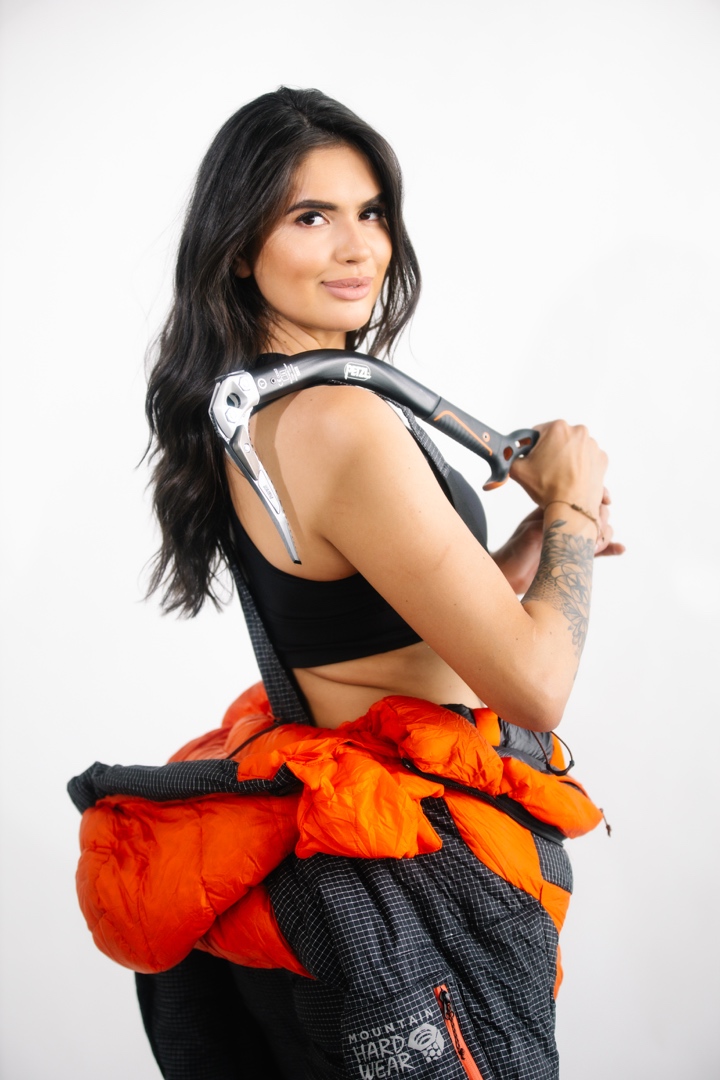Story and Editorial photography by
Annabella Mireles
Additional photography courtesy of
Kayla Perez
Everyone has something they are afraid of. Whether it’s as small as spiders, or something on a bigger scale, such as getting on an airplane, we all have to decide how far we’ll let those fears go from stopping us from experiencing life. Rather than letting fear steer us away from life-changing experiences because of the chance of failure or the unknown, people like Kayla Perez have used fear as a driving force to do the incredible, like climbing Mount Everest.
Perez climbed Everest in April of 2024, which took about two months to reach the summit and return to base camp one. Even reaching base camp one is a feat that not many can endure that requires a lot of physical and mental preparation.
She didn’t always have an interest in climbing, but Perez did always have a connection with nature and attributes her drive for adventure to her family.
“I grew up in Horizon City and we had a decent mid-size home, but we really didn’t have a lot growing up, so we were always playing outside,” Perez said. “We’d play in the streets and were always getting dirty. It was fun growing up with two older brothers and doing tons of outdoor sports. Our dad always had us at Elephant Butte or snow skiing at Ski Apache. I always had this fire inside me to just be outside and build this deep connection with nature.”
To build a closer relationship with nature, Perez wanted to challenge her fear of heights and became a private flight attendant. However, in 2020, she was inspired to take it a step further when she watched a documentary on the 14 highest mountains in the world.
“I had a connection with nature, but I also had a fear of heights,” she said. “I thought that it would be interesting to do something out of my comfort zone. I wanted to not only come face-to-face with my fear, but be as uncomfortable as I can be. What really defines you is when you allow yourself to be as uncomfortable as can be to really allow ourselves to unlock so much untapped potential.”
Perez started climbing in 2020 and set her eyes on Mount Shasta in Northern California as her first big climb, followed by Mount Baker and Mount Rainier – and she eventually made her way to the Himalayas.
“When you face something that seems impossible, you inspire others to go for it too, and it is addictive trying to become the best version of myself. I needed people to know that anything’s possible in life.”
Although Perez has had many successful climbs, she also shared her more challenging experiences, like getting pulmonary edema while climbing Manaslu and battling Raynaud’s disease which causes reduced blood flow to the extremities.
“I didn’t summit the first time and I got airlifted out,” she said. “It was terrifying because it feels like you’re drowning in your lungs. The weather will set in, and you have to be on oxygen to supplement it because if you don’t descend within 24 hours, you can die from pulmonary edema. The only cure for it is to just descend because it’s altitude induced.”
Despite experiencing a life-threatening event, Perez didn’t let this stop her from continuing her passion and went on to pursue Mount Everest, although she originally planned to climb Lobuche, a smaller mountain near Mount Everest.
“Because I formerly had pulmonary edema twice, I wanted to test out the altitude on a similar peak that was a similar altitude to Manaslu. Climbers from Everest and Lobuche share the same base camp. While I was there, I just kept staring at Everest, and I told myself that I was ready. I had medication from my doctor to avoid getting pulmonary edema again and I was properly acclimatized, so I called my sponsor and decided I was going to go for it.”
The climb to Mount Everest lasted from April 5 to May 24 of 2024.
During the climb, Perez was accompanied by about 12 other people and sherpas, members of an ethnic group who live in the eastern Himalayan region and guide climbers to reach the summit. These expert climbers also help carry equipment up to base camps and set up ladders and safety ropes to help make the climb safer.
“You’re getting really close to these people because you’re with them 24/7,” she said. “We’re all bonding because we are all crazy enough to climb this mountain. It’s people from different careers and different backgrounds, and we are all sharing the same experience. People prepare their whole year to climb this track. You’re constantly jumping and climbing up, down, and around. You really have to maneuver your way through this icefall that changes every day.”
In addition to dealing with curvaceous and tricky paths, climbers must deal with the extreme cold and extreme living conditions.
“We had a kitchen in the tent and a stove, which was all carried up by the sherpas,” she said. “They mainly cook traditional Nepali food like Dal Bhat which has rice, veggies or meat, and lentils. But as we got higher and higher, I was just eating ramen noodles every day and wasn’t getting many nutrients. I was running on fumes, and at that point, I didn’t get much sleep. My digestive system was all over the place and my health was just declining every day.”
Although most people may first think of the physical hardship climbers face, their mental state is equally as impacted.
“When I was going to the higher camps, I would stay back because I was feeling so weak,” she said. “The team would keep going, so it was just me and my sherpa. I didn’t really have that sense of community or support at that time. I was alone with just my thoughts and my journal. It starts to become a mind game, because you have been there for so long and you’re so tired and want to give up at any moment. You’re now in these places where if you give up, you die.”
Just under 1000 people attempt to climb Everest each year, and only 500 of them reach the peak. Although not everyone can try the climb, those who do, such as Perez, must maintain a positive attitude.
“Your mind is more powerful than you can ever imagine,” she said. “You’re capable, you just have to keep walking. You have to embrace the suck. That’s how you find a newfound strength you never thought you had.”
During the climb, Perez said that while she was having a hard time on her summit push, she felt a presence that she believes was her late friend and climber, Anna Gutu, who passed away in October of 2023 from an avalanche.
“I felt this immense pain in my stomach and felt like I was going to throw up,” she said. “I couldn’t even climb more than three feet. Anna popped into my mind, and I just felt her presence and this embrace of strength and love. I felt like I could hear her say ‘Don’t worry, you got this.’”
After finally reaching the summit, Perez said that she was honored to be able to represent El Paso, and hopes to inspire others to get out of their comfort zones.
“It was very humbling,” she said. “Everyone knew I had the hardest time on the mountain, so when I got to the top, I immediately dropped to my knees and thanked God. I prayed in thanks that I was alive and still had air in my lungs because there’s a lot of people that don’t make it off that mountain.”
The adventure doesn’t stop at Mount Everest for Perez, who now lives in Las Vegas.
In fact, she received her scuba diving license last year and plans on taking an international motorcycle trip with her brother and father. As for climbing, she plans on leading a team to Mount Kilimanjaro in December and is working on growing her organization American Alpine Girls, an organization dedicated to connecting climbers.
“I want to grow American Alpine Girls and get anyone who wants to climb and share the love of the mountains and the rocks with them,” she said. “Overall, it’s just about passion and getting over comfortability. That was the mindset Everest gave me, getting comfortable with being uncomfortable.”
















